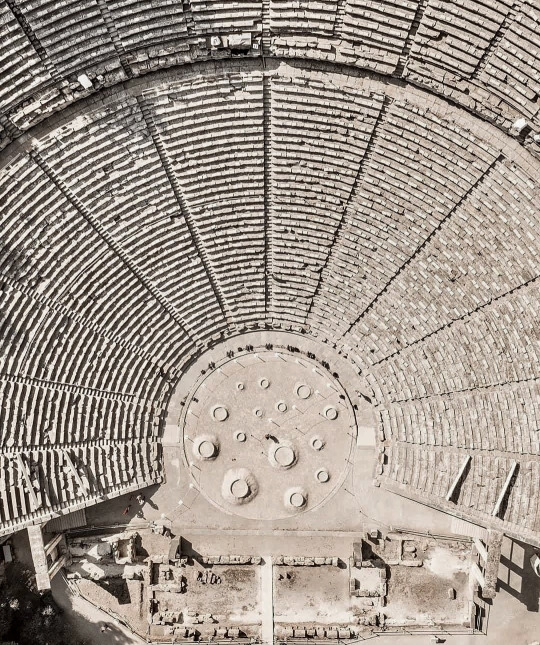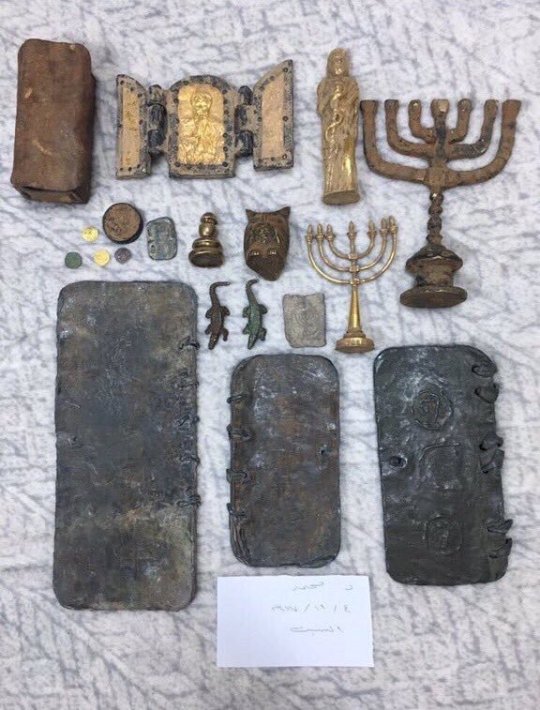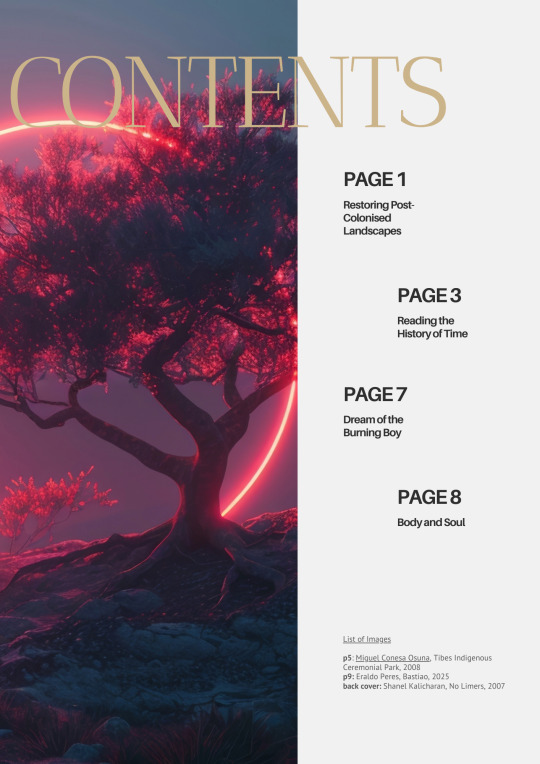#ancienthistory
Explore tagged Tumblr posts
Text

The ancient theatre of Epidavros, Peloponnese, Greece. 4th c.BC.
9K notes
·
View notes
Text

Jewish artifacts found at an excavation site in Tayma, Saudi Arabia. Tayma was a Jewish oasis during the pre-Islamic era. It was the hometown of Jewish poet Shmuel Ben Adiya, famous for his unconditional loyalty towards Prince Imru al Qais in the 6th century.
Tayma, along with Khaybar were the two most important oasis in the Hejaz region (modern Saudi Arabia) that used to have a strong jewish presence until the fall of Khaybar in 628 (4388 - 4389 in the hebrew calendar) when the first muslims conquered the fortress and expelled most of the jewish population.
#archaeology#jewisharchaeology#judaism#jewish#jewishhistory#jews#history#ancienthistory#ancient#saudiarabia#saudihistory#khaybar#tayma#artifacts#preislamic#israel#israeli
1K notes
·
View notes
Text

View of Pit 1, the largest excavation pit of the Terracotta Army, China, 3rd century BCE. The Terracotta Army is a collection of terracotta sculptures depicting the armies of Qin Shi Huang, the first emperor of China. It is a form of funerary art buried with the emperor in 210–209 BCE with the purpose of protecting him in his afterlife.
#china#chinese art#chinese history#chinese culture#ancient china#terracotta warriors#terracotta#ancient sculpture#ancient art#ancienthistory#ancient culture#antiquité#antichità#han china
90 notes
·
View notes
Text

facts
#ancienttimes#ancienthistory#history#ancientgreeks#ancientromans#greeks#romans#dog#puppy#dogfacts#historyfacts#facts#wowfacts#fact#fur baby
198 notes
·
View notes
Text
Just a meme I came up with: A 16th-century Western historian on his way to renaming the 'Eastern Roman Empire' to the 'Byzantine Empire' 🤔📜👨🏫💭
#Meme#History#Humor#Byzantium#EasternRomanEmpire#Historian#16thCentury#Revisionism#ByzantineEmpire#Funny#Comedy#AncientHistory#WesternHistorian#HistoricalMeme#ImperialHistory#RomanEmpire#HistoryMemes#HistoryNerd#HistoricalHumor#MemeCommunity#HistoryLovers#memes#memesfunny#historymemes
22 notes
·
View notes
Text

I'll be posting some of these illustrations I did for a cool short story project about the power of seeking value outside of material desires. And it has an Asian feels, which was a nice contrast to so much of the Greek design works. 🤘😁🤘
#mythology tag#percyjackson#dark academia#classical literature#percy jackon and the olympians#iliad#classics#mythologyart#art#artists on tumblr#odyssey#literature#ancientworld#ancienthistory#ancient civilizations#fantasyart#asianmythology#illustration
67 notes
·
View notes
Text

"Dreaming is a religious rite."
Welcome to #TNL № 6. This season we’re contrasting Western temporalities with Aboriginal wisdom. Featuring analysis, imagery and narratives on decolonization, feminist advocacy, and reclaiming ancestral narratives.
Spring 2025.
14 pages.
We’re thankful for your support of TNL. Got questions, comments or suggestions on this post? The best place to reach us is our dedicated support page.
7 notes
·
View notes
Photo

Glass goblet with gilded silver fittings, Norway, 6th century AD from The Museum of Cultural History, Oslo Source: khm.uio.no
51 notes
·
View notes
Text


9 notes
·
View notes
Text
Bronze Age sarcophagus lid

ITEM Sarcophagus lid MATERIAL Pottery CULTURE Bronze Age, Canaanite PERIOD 1400 - 1200 B.C DIMENSIONS 270 mm x 157 mm x 35 mm CONDITION Good condition PROVENANCE Ex Museum Exhibiton of the Arbeitsgruppe für Biblische Archäologie, Germany (Deaccession) The Canaanite sarcophagus lid is an extraordinary artifact that sheds light on the burial practices and artistic traditions of the ancient Canaanite civilization, which flourished in the Levant region from the Bronze Age to the Iron Age. These lids, typically crafted from stone such as limestone, were designed to cover sarcophagi, or stone coffins, that housed the deceased. The lids often featured intricate carvings and reliefs, reflecting both the artistic abilities of the Canaanites and their beliefs about the afterlife. Many Canaanite sarcophagi, particularly from the Late Bronze Age, show a fusion of Egyptian and local Canaanite influences, indicating the strong cultural exchange between these civilizations. One notable characteristic of Canaanite sarcophagus lids is the stylized human face or mask often carved into the stone. This representation of the deceased, though somewhat abstract, was believed to honor and preserve the identity of the individual in the afterlife. The facial features, typically simple and symmetrical, were not highly personalized but followed conventional designs, which might have reflected the Canaanite belief in the continuity of the soul beyond physical death. Read the full article
#ancient#ancientart#ancienthistory#artefact#artifact#ancientartifacts#antiquities#antiquity#art#artobject#ancientworld#history#classical#archaeology#pottery#vessel#canaan#bronzeage#sarcophagus#lid#egypt#egyptian
8 notes
·
View notes
Text
My Iconography – Silkscreen, printed by the artist. A series of 12 prints in a strictly limited edition of 15 prints. Image size 9 × 13 cm, paper size 11 ×15 cm, on 300 gsm cartridge paper. Available singly or as a set, signed and embossed with the artist’s seal.
These prints form part of the Tableaux of Dreams collection, a deeply personal set of paintings, drawings, and prints.
#art#artist#printmaker#printmaking#tableaux_of_dreams#icon#symbol#hieroglyphs#mythology#legend#fantasy#ancienthistory#pagan#magic#memory#ArtModerne#PeintureAbstraite#AbstrakteKunst#ModerneKunst#AbstrakteMalerei#ImpresiónLimitada#Grabado#ArteDeGalería#ancientegypt#greekmythology
3 notes
·
View notes
Text

2K notes
·
View notes
Text

the battle of alexander at issus by albrecht altdorfer (1529)
#the battle of alexander at issus#albrecht altdorfer#1500's#battle of issus#renaissance#alexander the great#ancienthistory
15 notes
·
View notes
Text

Drawing of Sasanian rock relief: Ardashir I (r. A.D. 224-241) and the Zoroastrian divinity Ohrmazd [Ahura Mazda] at Naqsh-i Rustam, southern Iran, Lutf-'Ali Shirazi Iranian, 1812. MET (ID: 1998.6.3). This drawing of a Sasanian rock relief at Naqsh-i Rustam, Iran, depicts the investiture of Ardashir I (r. 224-241), who receives the ring of office from the supreme Zoroastrian god Ohrmazd, also known as Ahura Mazda. Both king and god are on horseback; the king wears a caftan, the prestigious riding costume of the Sasanian period, and his fan-bearer stands behind him. The horses trample the bodies of the last Parthian king, Ardavan, and the Zoroastrian evil spirit Ahriman. The drawing is one of several in the Metropolitan’s collection made by an Iranian artist Lutf-'Ali Shirazi (1998.6.1; 1998.6.2; 1998.6.4): they are comparable to renderings of Sasanian carved and rock monuments produced by early European travelers to Iran. (MET)
#iran#iran history#iran art#iran culture#persia#ancient persia#zoroaster#persian history#persianart#persian culture#ancient#ancienthistory#ancientart#ancient culture#sasanian#sasanid#sassanid#sassanid empire
27 notes
·
View notes
Text

facts
🌼 Magnolia is an ancient genus. Appearing before bees evolved, the flowers are theorized to have evolved to encourage pollination by beetles. To avoid damage from pollinating beetles, the carpels of Magnolia flowers are extremely tough. Fossilized specimens of M. acuminata have been found dating to 20 million years ago, and fossils of plants identifiably belonging to the Magnoliaceae date to 95 million years ago. Another aspect of Magnolia that represents an ancestral state is that the flower bud is enclosed in a bract rather than in sepals; the perianth parts are undifferentiated and called tepals rather than distinct sepals and petals. Magnolia shares the tepal characteristic with several other flowering plants near the base of the flowering plant lineage such as Amborella and Nymphaea (as well as with much more recently derived plants such as Lilium).
#magnoliaflower#magnolia#flower#flowers#pollination#beetles#bees#ancienthistory#historyfacts#sciencefacts#funfacts#wowfacts#facts#didyouknow
19 notes
·
View notes
Text

Has archaeology provided us with any data to indicate that Joseph, Moses and ancient Israel were in Egypt? What was the Red Sea, where was the exodus route and can Mount Sinai be found today? These are the questions that must be answered in this exciting photographic expedition in Egypt.
#ExodusEvidence#Exodus#Israel#Egypt#RedSea#MountSinai#Hebrews#Hebew#Semetic#Goshen#BiblicalArchaeology#BibleArchaeology#Archaeology#Pharaoh#Bible#Scripture#Backholer#PaulBackholer#ByFaithMedia#ByFaith#ChristianReads#ChristianLiterature#ChristianAuthor#God#Jesus#Amen#TheExodusRoute#History#AncientHistory#Lord
15 notes
·
View notes